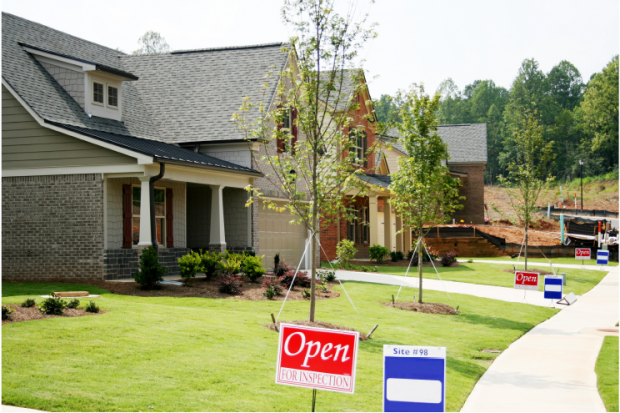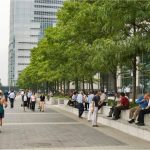New Jersey Future Blog
Five Community Planning Initiatives To Solve Problems and Save Money
June 6th, 2023 by Chris Sturm
Local officials face a rapidly changing world due to forces beyond their control. Impacts from the pandemic, climate change, and the racial reckoning cannot be ignored, nor can new state government requirements, ranging from housing to flood resilience. But by investing in community planning initiatives, municipal and county leaders can solve problems, save money, and strengthen their communities. Five especially pressing community issues in 2023 are: fulfilling Mount Laurel requirements for affordable housing, growing communities without displacement, navigating real estate market shifts, adapting to climate change, and decreasing pedestrian fatalities.
Mount Laurel Requirements for affordable housing. New Jersey municipalities are experiencing accelerated construction of deed-restricted affordable housing and associated market-rate housing, as described in a new report, Dismantling Exclusionary Zoning: New Jersey’s Blueprint for Overcoming Segregation, Between 2015 and 2022 New Jersey’s Mount Laurel housing requirement resulted in the construction of nearly 22,000 new deed-restricted affordable housing units and an additional 50,000 multi-family housing units in “Mt. Laurel associated projects”. The pace of affordable housing production will increase as additional approved units are built. Meanwhile, these new housing units are creating much-needed homes for people and families across the state.
The next phase of affordable housing requirements, called “the Fourth Round,” will commence on July 1, 2025. The 350 or so affected municipalities can begin planning now for Fourth Round requirements so they can increase supply, variety, and affordability of housing stock and remain an attractive place for households of all types and incomes. Proactive municipalities are identifying the most advantageous sites and getting them ready. Win-win-win sites are well-located near jobs, schools and shopping; redevelop vacant or underutilized properties rather than natural lands; are served by water infrastructure, and are resilient to flooding. Sites in downtown locations can also boost economic development. But some of the best sites have obstacles to housing production that take time to resolve. Municipalities that begin now will find themselves better able to steer future housing construction than those that wait until deadlines loom. Adopting an inclusionary zoning ordinance that requires a share of new housing units be affordable gives municipalities another head start.

Inclusive Communities. Affordable housing in affluent areas represents just one side of the coin when it comes to reducing the high racial and economic segregation of New Jersey’s communities. It can be complemented by attracting market-rate development to poorer communities—but only if those developments benefit, rather than harm, existing residents and businesses. For example, new market-rate development can spark a wave of investment that escalates rents and property taxes, which in turn displaces residents and small businesses. Redevelopment planned without community input can undermine neighborhood cohesion and quality of life.
Proactive cities are finding ways to ensure residents benefit from new investment. Jersey City, Newark, and others have adopted inclusionary zoning ordinances that require creation of affordable housing units as a part of new development projects. This ensures some units remain affordable to those with lower incomes even as real estate values rise. If well structured, Community Benefit Agreements can ensure that developers provide tangible benefits tailored to local needs. For example, they can guarantee jobs for local residents, deliver investments in desired neighborhood amenities, and ensure local input into project designs. Community Benefits Agreements (CBAs) are now required for certain projects funded through two of the New Jersey Economic Development Authority’s tax incentive programs. Cities can employ many additional strategies, including giving existing residents a strong voice in decision-making.
Real Estate Market Shifts. The coronavirus pandemic accelerated market forces that are reshaping communities. The shift to remote work and hybrid schedules have cut office occupancy rates, affecting the vitality of downtowns, office parks and corporate campuses, and undermining restaurants and other businesses that cater to workers. The surge in e-commerce has also hurt the already shrinking storefront retail sector. Some of these trends may revert to pre-pandemic levels as the pandemic recedes, but others are likely to stick, and local governments need to adapt.
Cities and towns are beginning to seek ways to convert vacant office and retail spaces for new uses, such as housing, which is in short supply in New Jersey. Suburban office parks and malls offer opportunities for creating new mixed-use centers where none existed before, by repurposing existing buildings and by adding new buildings and uses on surface parking lots.
E-commerce has also fueled a spike in demand for warehousing, superimposed on top of trends in international trade that are increasing the volume of goods arriving at the state’s major ports in North Jersey. The rising demand for logistics facilities of all sizes has caught many communities by surprise. Affected municipalities can employ the tools provided in the Warehouse Siting Guidance from the Office of Planning Advocacy in order to proactively plan for and locate warehouse development in a manner that avoids negative impacts.
At the same time, New Jersey’s population is aging, and many municipalities are working to design their communities in ways that support older adults. Changes that help us remain in our communities as we age also benefit people of all ages. These include having a greater range of housing options, providing equitable access to open spaces and other facilities, supporting downtown economies, and improving transportation and walkability.
Flooding and other Climate Change Impacts. Due to sea level rise in coastal areas, and more intense precipitation events statewide, many developed areas face more frequent and more intense flooding. In response, the NJ Department of Environmental Protection has updated projections for precipitation and sea level rise and municipal permits addressing water quality, particularly due to stormwater runoff. The Department is also considering multiple regulations that will impact municipal stormwater management, development in flood prone areas, and re/development standards.
Prudent municipalities are investing resources to assess their vulnerabilities to climate change and understand new regulatory and planning requirements. A climate change-related hazard vulnerability assessment, now required in the land use element of municipal master plans, is a foundational first step in local climate adaptation; stay tuned for detailed guidance from New Jersey Future later this year. Strategies to limit flood damage to property and people include better stormwater management, more resilient design standards, and in some places, transitioning away from high hazard areas through zoning changes and NJDEP Blue Acres buyouts. In order to fund infrastructure improvements that address flooding, many towns are exploring creation of a stormwater utility.
 Pedestrian Safety. In a 2022 report, New Jersey ranked as the 19th most dangerous state for pedestrians, with 870 pedestrian deaths in the five-year period between 2016 and 2020. The most dangerous roads in New Jersey for pedestrians are usually four- or six-lane highways in developed areas with a large amount of commercial businesses but few sidewalks and intersections. At the same time as pedestrian deaths are rising, state policy encourages greater reliance on walking and biking since they are climate-friendly transportation options that emit no greenhouse gas emissions. As long as our crosswalks put pedestrians in the crosshairs, we will fail to see broad adoption of walking as a primary mode of zero emissions transportation through our communities.
Pedestrian Safety. In a 2022 report, New Jersey ranked as the 19th most dangerous state for pedestrians, with 870 pedestrian deaths in the five-year period between 2016 and 2020. The most dangerous roads in New Jersey for pedestrians are usually four- or six-lane highways in developed areas with a large amount of commercial businesses but few sidewalks and intersections. At the same time as pedestrian deaths are rising, state policy encourages greater reliance on walking and biking since they are climate-friendly transportation options that emit no greenhouse gas emissions. As long as our crosswalks put pedestrians in the crosshairs, we will fail to see broad adoption of walking as a primary mode of zero emissions transportation through our communities.
Proactive communities in New Jersey are retrofitting streets, including main streets, as “complete streets” that are consciously designed to be safe and inviting for all users–not only drivers, but also pedestrians and cyclists. They can obtain resources on complete streets from the New Jersey Department of Transportation (NJDOT) and the Bicycle and Pedestrian Resource Center and adopt a model complete streets policy. They should also apply for project grants from the following local aid programs: Bicycle and Pedestrian Planning Assistance, Safe Routes to School, and Safe Streets to Transit.
Community Planning Success Stories. It’s all too easy to put off community planning projects until nagging problems become crises. Thankfully, leading county and municipal officials across New Jersey offer successful models for tackling affordable housing, inclusionary communities, real estate market shifts, climate change impacts, and pedestrian safety. Each of these topics, and many others, will be explored by expert practitioners at in-depth workshops at the 2023 Planning and Redevelopment Conference on June 21–23. Additional panels will focus on the role that the state and federal government play in planning and redevelopment, including one featuring an expected update to the New Jersey State Development and Redevelopment Plan. Seize the day and invest in planning to solve problems and save money.
Related Posts
Tags: Affordable housing, climate change, community, flooding, Housing, housing and equity, inclusion, Local Planning, Pedestrian, planning, safe streets
















